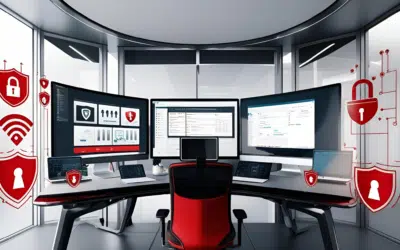As technology continues to expand and improve, many people have come to prefer to use their own systems over their office’s tech offerings. This is largely because many of us have newer personal devices that allow us to do so much more than the computers we use at our office. As a result, the issue of BYOD (Bring Your Own Device) has become far more important, especially due to the fact that if left unchecked, BYOD could pose a security risk to your organization.
What should I do about BYOD?
The first reaction of many office managers and business owners, worried about security threats that could stem from BYOD, is to impose an outright ban of devices. While telling your staff they are not to use their devices for work may seem like a quick and easy solution, you can be 100% sure that there will be employees who ignore this policy and use their personal devices for work regardless.
This could put your business at a higher security risk if the rule is ignored, especially if you don’t implement any security measures to protect your networks and data. In order to minimize the potential threats BYOD can expose your business to, we suggest you do the following:
1. Consider embracing BYOD
Instead of simply banning personal devices in the workplace take a step back and look to see if there are any benefits BYOD can offer. For example, if you operate on razor thin margins and have not replaced hardware in years, there is a good chance your employees will have better systems at hand. This could help you reduce your overall tech costs.
The same goes for phones for your employees. Why not offer to pay for the plan and allow employees to use their own devices? Of course, you are going to want to implement security measures and usage rules, but if this is easily achieved then it may help reduce your overall operating costs. Before you do implement a system like this however, we strongly recommend you read the rest of this article and follow the steps below.
2. Set up separate networks for employee devices
Oftentimes, the main reason employees bring their devices to the office and use them for work purposes, especially when it comes to mobile phones, is because they can happily connect to Wi-Fi for free without using their data plans throughout the day.
Chances are high that because they use the work Wi-Fi on their device for non-work tasks, they simply keep using the device when they are doing work related activities. This could pose a security risk, especially if you run business-critical operations on the same network. You could nip this potential problem in the bud and simply install another Wi-Fi network for mobile devices and non-critical business processes.
It is usually quite affordable to simply purchase another line and the networking equipment to support this, not to mention the fact that it will keep business-critical processes secure from errant malware. As an added bonus, you will likely see increased productivity because the bandwidth demand will be limited, so important data will move quicker.
3. Educate your staff about security
In our experience, the vast majority of BYOD related security risks are exposed by mistake. An employee may have a virus on a personal phone and be unaware of it. When they connect to the network it can then be unintentionally spread to other computers resulting in a potentially massive security breach.
One of the simplest ways to prevent this is to educate your employees about proper mobile safety. This includes how to spot apps that could contain malware, sharing security threat updates, and teaching your employees how to secure their devices. You really need to stress just how important security is to them.
On top of this, contact an IT expert like us for a recommended anti-virus and spyware scanner for mobile devices that users can easily install. Encourage employees to not just install this but to keep it up to date too. Many of these mobile specific scanners are free and just as powerful as desktop versions.
4. Work with an IT partner to establish a solution that works for you
Beyond education and simple network establishment, it is a great idea to work with an IT partner like us. As experts, we keep tabs on the trends and solutions related to BYOD and will work with you to establish a program that works for your company.
It may be that you don’t actually need to integrate BYOD but to update hardware or software to newer versions instead. It could be that there is a simple solution to employees feeling frustrated with slow performance of existing systems at work.
If you do implement BYOD, we can help establish security measures and policies that will ensure your networks and employee devices are secure. The best advice we can give however, is to do this before you start allowing BYOD, as it can be far more challenging to implement and enforce changes when employees are already using their devices at work.
Looking to learn more? Contact us today to see how we can help.








